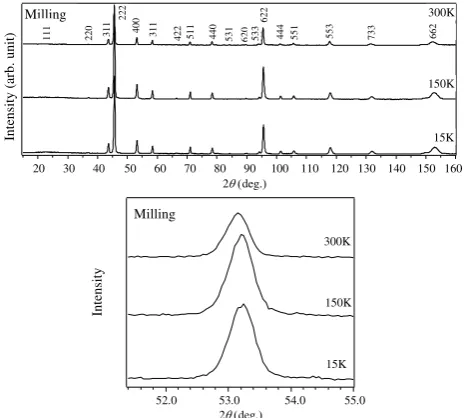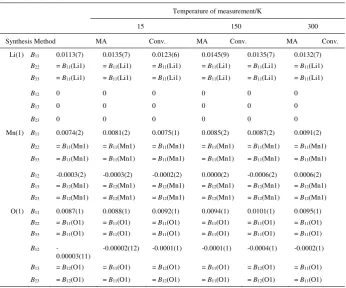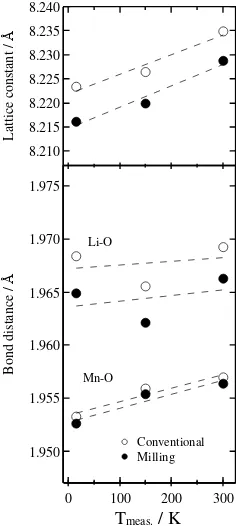Synthesis and Characterization of Stoichiometric
Spinel-LiMn
2
O
4
T.Y.S. Panca Putra
1*,
Deswita
1, A. Insani
1, H. Mugiraharjo
1,
E. Sukirman
1, A.K. Jahja
1, T.H. Priyanto
1, S. Lee
2and T. Kamiyama
31Center for Science and Technology of Advanced Materials, National Nuclear Energy Agency,
Kawasan Puspiptek Serpong, Tangerang Selatan 15314, Indonesia
2High-Flux Advanced Neutron Application Reactor, Korea Atomic Energy Research Institute (KAERI),
150-1 Deokjin-Dong, 1045 Daedeokdaero, Yuseong-gu, Daejeon 305-600, Korea
3High Energy Accelerator Research Organization, 1-1 Oho, Tsukuba, Ibaraki 305-0801, Japan
A R T I C L E I N F O A B S T R A C T
Article history:
Received 29 October 2016
Received in revised form 6 November 2017 Accepted 9 November 2017
In this study, spinel LiMn2O4 powder was synthesized from LiOH.H2O and MnOx by conventional and mechanical alloying (MA) methods, followed by heat treatment at 800 °C in O2 for four hours with cooling to room temperature in the furnace at 60 °C/h. It is found that both samples do not show phase transition in low temperature, and this occurred for different reasons. In the MA sample, the presence of Fe as contamination increased the Mn valence and hindered the occurrence of phase transition. The conventional sample does not show phase transition at low temperature due to stoichiometric content, without any contamination. In general, the absence of phase transition occurred due to synthesis condition employed in this study.
© 2017 Atom Indonesia. All rights reserved
INTRODUCTION parameter, stoichiometry, average Mn valence,
surface morphology, and homogeneity [1-5]. In practice, these factors are closely related to the
synthesis method and condition, such as starting material, content of lithium, heating temperature, holding time, and cooling rate [6-12].
It is important to ensure that LiMn2O4
contains a sufficient amount of Mn4+ and a low
content of Mn3+ in order to maintain average
Mn valence above 3.5+. Lower average Mn valences
will cause Jahn-Teller distortion during
electrochemical processes and lead to capacity
fading of spinel LiMn2O4 [13]. The spinel LiMn2O4
critical point, and will easily be interfered even by a slight change in synthesis condition, due to charge compensation. Previous works suggested some factors responsible for a phase transition in spinel
vacancies and its presence is the sole and necessary condition for the phase transition, not the synthesis temperature or the thermal treatment history [16].
It was proposed that in a strictly stoichiometric sample, this phase transition should not occur. In order to obtain a strictly stoichiometric
LiMn2O4, a synthesis method should be selected
carefully while the synthesis condition should be controlled simultaneously. Mechanical alloying (MA) and conventional mixing method in a mortar are common among many methods used to
synthesize LiMn2O4, and previous works showed
various results of LiMn2O4 synthesis. In this paper,
the use of both methods is reported and the
Atom Indonesia
relationship among the synthesis condition, the physical properties, and the stoichiometry of the
spinel LiMn2O4 are described. In particular, the
stoichiometry of the synthesized LiMn2O4 and the
structure were determined in relation to the occurrence of phase transition. Characterizations
were carried out by several methods, namely
by scanning electron microscope (SEM),
thermogravimetry-differential thermal analysis
(TG-DTA), and X-ray diffraction (XRD). In order to accurately determine the site occupancies of light atoms such as lithium, or even oxygen, in the presence of manganese, and also to clarify structural
details of spinel LiMn2O4, neutron powder
diffraction (NPD) was employed [13]. NPD is a powerful and suitable means for structural determination because of the difference in the
coherent scattering lengths of atoms in LiMn2O4.
EXPERIMENTAL METHODS
Synthesis of spinel-LiMn2O4
Spinel LiMn2O4 was synthesized from
starting materials of LiOH·H2O as lithium sources
and MnOx obtained by thermal decomposition of
manganese oxalate. Stoichiometric amounts of
LiOH·H2O and MnOx were charged into a stainless
steel jar with an internal volume of 125 mL in molar ratio of Li/Mn=0.50. Mechanical alloying (MA) was carried out using a planetary ball mill (Retsch PM 200) and stainless steel balls (10 mm diameter) with various parameters. The weight ratio of balls and materials was 40:1. The rotation speed of the miller
was 500 rpm. Spinel LiMn2O4 was also synthesized
by conventional mixing of starting materials in a mortar for comparison. The mixtures were then
pressed into pellets and heated at 800 °C in O2 for
four hours with cooling to room temperature in the furnace at 60 °C/h.
Characterization of spinel-LiMn2O4
The morphology of the spinel was analyzed using the JEOL JSM-6510LA SEM at PSTBM-BATAN, Indonesia. Thermal analysis was
conducted with a Setaram TAG-24S DTA/TG at Ibaraki University, Japan, using alumina crucible,
in argon. The rate of heating was 10 °C/min. The structure of the as-prepared powders was
studied by X-ray diffraction (Rigaku Ultima
IV XRD) at Rigaku, Japan, using Cu K radiation
at the temperature range of 20 °C to -180 °C. The lattice parameter of prepared spinel phases was
analyzed by built-in software package PDXL with Si as reference. Neutron diffraction data were
measured at the neutron HRPD of
HANARO-KAERI, South Korea ( = 1.83433 Å) at 15 K,
150 K, and 300 K, while neutron diffraction data of
standard LiMn2O4 measured at 300 K were obtained
from HRPD of BATAN, Indonesia ( = 1.82230 Å).
Figures 1(a) and 1(b) show the morphology of
spinel samples synthesized from LiOH.H2O and distinctive individual granules whose size is about several hundreds nanometers and some aggregation. In general, the annealing process with the same conditions for both samples caused the particles growth and aggregation of smaller particles regardless of the initial mixing methods.
(a)
(b)
Fig. 1. SEM micrograph of the spinel-type LiMn2O4
synthesized with an initial molar ratio of Li/Mn = 0.50 (a) after MA for 6 hours and (b) conventionally prepared, and after annealed at 800 oC for 4 hours in O2 then cooled with cooling rate of 60 oC/h.
Figure 2 shows TG profiles and DTA curves of Li-Mn-O mixtures synthesized by MA for six hours and by conventional method, then annealed
to room temperature with cooling rate 60 °C/h. The DTA curves of both samples show similar patterns. The related TG profile of both samples shows that the mass changed gradually until around
700 °C and then declined sharply until 900 °C. The common value of mass loss in MA sample is
lower than in the conventional sample at all temperatures. Therefore, it serves as evidence that the MA sample has a better thermal stability than conventional sample because the mixing of raw materials during MA was more controlled throughout the process, which leads to a consistent contact and reaction between raw materials powder.
Above 800 °C, both samples show mass losses and are related to the decomposition process
of LiMn2O4.
Fig. 2. TG-profiles and DTA-curves of the mixture
of LiOH.H2O and MnOx with an initial molar ratio of Li/Mn = 0.50 synthesized by MA for 6 hours and conventional
method and subsequent annealing at 800 oC for 4 hours in O2 with cooling rate of 60 oC/h.
Figure 3 shows the XRD patterns of the
spinel LiMn2O4 synthesized from LiOH.H2O and
MnOx by conventional and MA methods, measured
at temperature range from room temperature down to 93K. Previous works [19,20] showed that at room
temperature, stoichiometric spinel oxide, LiMn2O4,
display a cubic, normal spinel structure (space group
Fd-3m). The transformation should start at near
room temperature (~290 K) and is shown by peak splitting of the spinel diffraction lines with decreasing temperature. The diffraction patterns
from the samples synthesized from LiOH.H2O and
MnOx by conventional and MA methods in this
study, however, did not show any significant changes such as peak splitting down to 93 K, as shown in Figs. 3(b) and (d).
(a)
(b)
(c)
(d)
Fig. 3. XRD patterns of the spinel-type LiMn2O4 synthesized
with an initial molar ratio of Li/Mn = 0.50 by conventional method (a) and (b) and MA method for 6 hours (c) and (d) and annealed at 800 oC for 4 hours in O2 then cooled with cooling
rate of 60 oC/h. (a) and (c) 2 region from 34.5 o to 49 o and (b) and (d) peaks of (400) plane.
In Fig. 4(a), however, it is revealed that lattice
constant a increased with temperature. Peak
broadenings, shown as FWHM in Fig. 4(b), are observed for all reflections and getting larger as measurement temperature decreased. It is notable that peak broadening was larger and lattice constant
a was smaller for conventional mixing sample
Intens
ity
(a
rb.
unit
)
Intens
ity
(a
rb.
unit
)
Intens
ity
(a
rb.
unit
)
Intens
ity
(a
rb.
unit
compared with MA sample. The result indicates that phase transition at low temperatures was not obvious for these samples.
Fig. 4. (a) lattice constant a of the cubic LiMn2O4 and (b)
Gaussian FWHM, plotted as a function of measuring temperature. The data were obtained by XRD measurements.
Fig. 5. Neutron diffraction patterns taken from
HRPD-HANARO of the spinel-type LiMn2O4 synthesized with an initial molar ratio of Li/Mn = 0.50 by conventional method and annealed at 800 oC for 4 hours in O2 then cooled with cooling rate of 60 oC/h. (a) whole pattern and (b) (400) peaks.
Fig. 6. Neutron diffraction patterns taken from
HRPD-HANARO of the spinel-type LiMn2O4 synthesized with an initial molar ratio of Li/Mn = 0.50 by MA method and annealed at 800 oC for 4 hours in O2 then cooled with cooling rate of 60 oC/h. (a) whole pattern and (b) (400) peaks.
Figures 5 and 6 show the neutron diffraction obtained with HRPD-HANARO of the spinel show the profile fitting of neutron diffraction data.
Fig. 7. Rietveld refinement patterns for neutron diffraction
measurement at 15K, 150K and 300K (HRPD-HANARO) of spinel LiMn2O4 synthesized by a) conventional and b) MA methods and annealed at 800 oC in O2. (c) commercial/standard LiMn2O4 measured at 300K (HRPD-BATAN).
Table 1. Refined structure parameters of spinel-LiMn2O4.
Temperature of measurement/K
15 150 300
Synthesis Method MA Conv. MA Conv. MA Conv.
Lattice
Parameter/Å a 8.22337(72) 8.21622(71) 8.22650(63) 8.22000(83) 8.23488(69) 8.22880(70)
Atomic Coordinates
Li(1) g 0.97271 1 0.97271 1 0.97271 1
x 1/8 1/8 1/8 1/8 1/8 1/8
B/Å2 0 0 0 0 0 0
Mn(1) g 0.96269 1 0.96269 1 0.96269 1
x 1/2 1/2 1/2 1/2 1/2 1/2
B/Å2 0 0 0 0 0 0
O(1) g 1 1 1 1 1 1
x 0.26320(7) 0.26307(7) 0.26271(6) 0.26281(8) 0.26307(7) 0.26296(7)
B/Å2 0 0 0 0 0 0
Fe g 0.01392 - 0.01392 - 0.01392 -
x 1/2 - 1/2 - 1/2 -
B/Å2 0 - 0 - 0 -
Cr g 0.00243 - 0.00243 - 0.00243 -
x 1/2 - 1/2 - 1/2 -
B/Å2 0 - 0 - 0 -
R-Factors S 1.68 1.51 1.48 1.19 1.15 1.09
Rwp/ % 14.6 14.3 12.5 16.0 14.1 14.7
Re/ % 8.67 9.44 12.7 13.4 12.2 13.5
Note:
Li(1) is located at 8a site with coordinates (1/8, 1/8, 1/8); Mn(1) is located at 16d site with coordinates (1/2, 1/2, 1/2);
O(1) is located at 32e site with coordinates (x, x, x).
Space group: Fd-3m (No. 227, origin choice 2).
Table 2. Anisotropic temperature factors (Å2)of spinel-LiMn2O4.
Temperature of measurement/K
15 150 300
Synthesis Method MA Conv. MA Conv. MA Conv.
Li(1) B11 0.0113(7) 0.0135(7) 0.0123(6) 0.0145(9) 0.0135(7) 0.0132(7)
B22 = B11(Li1) = B11(Li1) = B11(Li1) = B11(Li1) = B11(Li1) = B11(Li1)
B33 = B11(Li1) = B11(Li1) = B11(Li1) = B11(Li1) = B11(Li1) = B11(Li1)
B12 0 0 0 0 0 0
B13 0 0 0 0 0 0
B23 0 0 0 0 0 0
Mn(1) B11 0.0074(2) 0.0081(2) 0.0075(1) 0.0085(2) 0.0087(2) 0.0091(2)
B22 = B11(Mn1) = B11(Mn1) = B11(Mn1) = B11(Mn1) = B11(Mn1) = B11(Mn1)
B33 = B11(Mn1) = B11(Mn1) = B11(Mn1) = B11(Mn1) = B11(Mn1) = B11(Mn1)
B12 -0.0003(2) -0.0003(2) -0.0002(2) 0.0000(2) -0.0006(2) 0.0006(2)
B13 = B12(Mn1) = B12(Mn1) = B12(Mn1) = B12(Mn1) = B12(Mn1) = B12(Mn1)
B23 = B12(Mn1) = B12(Mn1) = B12(Mn1) = B12(Mn1) = B12(Mn1) = B12(Mn1)
O(1) B11 0.0087(1) 0.0088(1) 0.0092(1) 0.0094(1) 0.0101(1) 0.0095(1)
B22 = B11(O1) = B11(O1) = B11(O1) = B11(O1) = B11(O1) = B11(O1)
B33 = B11(O1) = B11(O1) = B11(O1) = B11(O1) = B11(O1) = B11(O1)
B12
-0.00003(11)
-0.00002(12) -0.0001(1) -0.0001(1) -0.0004(1) -0.0002(1)
B13 = B12(O1) = B11(O1) = B12(O1) = B11(O1) = B12(O1) = B11(O1)
The refinement fitted the adapted cubic Fd-3m
symmetry. A comparison was made between the
synthesized and standard LiMn2O4, as shown in
Fig. 7(c) of neutron diffraction pattern taken from HRPD-BATAN. The two samples show similar patterns without any peak splitting. The synthesized
LiMn2O4 had lattice constant a of 8.23488(69) Å
measurement temperature. During the refinement of conventional samples, the occupancies of oxygen at all measurement temperatures were found to be greater than one, indicating no observable oxygen deficiency and all samples being stoichiometric.
Fig. 8. Bond distances (Li–O, Mn–O) of the spinel-type
LiMn2O4 as a function of measurement temperature.
The refinement for MA samples by using stainless steel jar and balls also considered the Fe and Cr contents from chemical analysis by ICP-AAS [16]. The result shows fully occupied oxygen as well. transition. The result from data refinement shows that the oxygen sites were fully occupied. It was
therefore concluded that the absence of a phase transition is closely related to the synthesis condition employed in this study such as: the moderate synthesis temperature (800 °C), the use of
O2 atmosphere to induce more oxidative reaction,
the slow cooling rate (60 °C/h), and the use of more
reactive starting materials (LiOH.H2O and MnOx).
CONCLUSION
Spinel LiMn2O4 powder has been synthesized
by MA and conventional method. It was found that in the MA sample produced by using stainless steel jar and balls, the presence of Fe as contamination,
situated at Mn site (16d), increased the Mn valence
and hindered the occurrence of a phase transition. The conventional samples synthesized from reactive
starting material, i.e. LiOH.H2O and MnOx, and
annealed at 800 °C in O2 with slow cooling rate did
not show a phase transition at low temperature.
The phase transition in spinel LiMn2O4 at low
temperature as an indication of non-stoichiometric
LiMn2O4 did not occur in studies by means of XRD
and neutron powder diffraction (NPD). Generally, the absence of a phase transition was due to synthesis conditions employed in this study such as: the moderate synthesis temperature (800 °C), the
use of O2 atmosphere to induce more oxidative
reaction, the slow cooling rate (60 °C/h), and the use
of more reactive starting materials (LiOH.H2O and
MnOx). It is concluded that stoichiometric spinel
4. A. Mukhopadhyay and B.W. Sheldon, Prog.
Mater. Sci. 63 (2014) 58.
5. A. Tron, Y.D. Park and J. Mun, J. Power
Sources 325 (2016) 360.
6. D. Zhan, F. Yang, Q. Zhang et al.,
Electrochim. Acta 129 (2014) 364.
7. X.-W. Liu, J. Tang, X.-S. Qin et al.,
Transactions of Nonferrous Metals Society of
China 24 (2014) 1414.
8. S. Zhao, Q. Chang, K. Jiang et al., Solid State
Ionics 253 (2013) 1.
9. C.-L. Chen, K.-F. Chiu, Y.-R. Chen et al., Thin
Solid Films 544 (2013) 182.
10. D.-L. Fang, J.-C. Li, X. Liu et al., J. Alloys
Compd. 640 (2015) 82.
11. Y. Cai, Y. Huang, X. Wang et al., Ceram. Int.
40 (2014) 14039.
12. D. Zhan, Q. Zhang, X. Hu et al., Solid State
Ionics 239 (2013) 8.
13. T.Y.S. Panca Putra, M. Yonemura, S. Torii
et al.,Solid State Ionics262 (2014) 83.
14. N. West, K.I. Ozoemena, C.O. Ikpo et al.,
Electrochim. Acta 101 (2013) 86.
15. R. Kanno, M. Yonemura, T. Kohigashi et al.,
J. Power Sources 97-98 (2001) 423.
16. X.Q. Yang, X. Sun, M. Balasubramanian
et al., Electrochem. Solid-State Lett. 4 (2001)
A117.
17. R. Oishi, M. Yonemura, Y. Nishimaki
et al., Nucl. Instrum. Methods Phys. Res. A
600 (2009) 94.
18. R. Oishi-Tomiyasu, M. Yonemura,
T. Morishima et al., J. Appl. Cryst. 45
(2012) 299.
19. S. Bagˇcı, H.M. Tütüncü, S. Duman et al.,
J. Phys. Chem. Solids 75 (2014) 463.
20. P. Piszora, W. Paszkowicz, C. Baehtz et al.,



